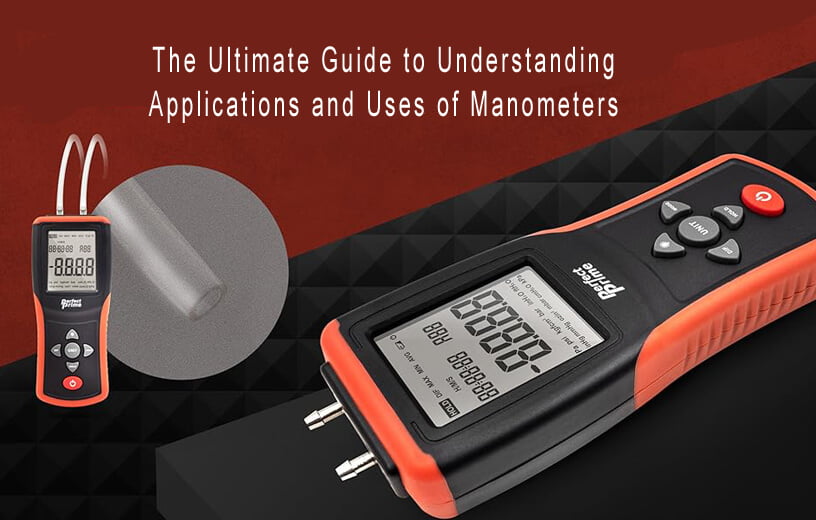- Water Testing Meters
- Anemometer
- Length & Distance Meter
- Multimeter & Clamp Meter
- Light and Sound Meter
- Slide Calipers & Screw Gauge
- Thermometer & Hygrometer
- Milk Testing Meters
- Paper, Grain & Wood Testers
- Stopwatch & Timers
- Soil Testing Meters
- Refractometers & Analyzer
- Magnetic Compass
- Tachometer & Megger
- Thickness & Dia-Meters
- Other Meter And Accessories
The Ultimate Guide to Understanding Applications and Uses of Manometers

Manometers are versatile instruments that are widely used in various industries for measuring and monitoring pressure. From HVAC systems to industrial processes, manometers play a crucial role in ensuring the efficient and safe operation of systems and equipment. But what exactly is a manometer and how does it work? In this comprehensive guide, we will explore the applications and uses of manometers, providing you with a deep understanding of their importance and how they can be utilized in different settings. Whether you are a professional in the field or simply curious about this essential instrument, this guide will equip you with the knowledge you need to navigate the world of manometers.

What is a Manometer and How Does it Work?
What exactly is a manometer and how does it work? In this section, we will delve into the details of this instrument, providing you with a comprehensive understanding.
A manometer is a device used to measure pressure, specifically the pressure difference between two points. It consists of a sealed tube filled with a fluid, typically mercury or water, and a scale to measure the height of the fluid column. When pressure is applied to one end of the manometer, the fluid level in the tube changes, indicating the pressure difference.
There are several types of manometers, including U-tube, inclined tube, and digital manometers. Each type has its own advantages and is suited for specific applications.
In operation, the manometer channels the applied pressure to one end of the tube, causing the fluid to rise or fall. The change in fluid height can be measured against a scale to determine the pressure difference accurately.
Understanding how a manometer works is essential as it forms the foundation for its various applications and uses. In the next section, we will explore the different industries and settings where manometers are commonly employed, showcasing their significance in maintaining safety and efficiency.
The Different Types and Uses of Manometers
In this section, we will discuss the different types of manometers and their applications. Understanding these variations will help you determine the most suitable one for your specific needs.
1. U-tube Manometers: This type of manometer is commonly used for measuring low-pressure differentials. It is widely employed in HVAC systems for monitoring air and gas pressures, as well as in chemistry labs for measuring pressure changes in experiments.
2. Inclined Tube Manometers: These manometers are designed for measuring higher pressure differentials. They are commonly used in the oil and gas industry, as well as in manufacturing processes that involve compressed air or steam.
3. Digital Manometers: With advanced technology, digital manometers offer accurate and easy-to-read measurements. They are widely used in industries such as automotive, aerospace, and pharmaceutical, where precise pressure readings are crucial.
Understanding the different types of manometers and their applications is key to selecting the right tool for your specific requirements. In the following section, we will further explore the uses of manometers in industries such as healthcare, automotive, and environmental monitoring. Stay tuned!
Common Uses of Manometers in Various Industries
In this section, we will explore the common uses of manometers in various industries. Understanding the practical applications of manometers will provide you with a comprehensive understanding of their versatility.
In the healthcare industry, manometers are extensively used for measuring blood pressure, both in clinical settings and at home. This vital tool enables healthcare professionals to monitor patients’ cardiovascular health and make accurate diagnoses.
Furthermore, manometers play a crucial role in the automotive industry. They are used for measuring pressure in fuel systems, ensuring the efficient flow and regulation of fuel. Additionally, manometers are utilized in engine diagnostics to detect any abnormalities in pressure that may indicate mechanical issues.
Manometers are also invaluable in environmental monitoring. They are employed for measuring air pressure, providing crucial data for weather forecasting, evaluating air quality, and monitoring air pollution levels.
By understanding the applications of manometers in these industries and more, you can make informed decisions about how to effectively use them in your specific field. In the next section, we will delve deeper into the intricacies of using manometers in healthcare settings. Stay tuned!
Choosing the right one for uses of manometers as your needs
In the previous section, we discussed the various applications of manometers in different industries. Now, let’s dive into the details of choosing the right manometer for your specific needs.
When selecting a manometer, the first consideration is the type of pressure you need to measure. Manometers come in different types, such as U-tube, inclined, and digital, each suited for different pressure ranges.
Next, consider the environment in which you will be using the manometer. If you work in a rugged or hazardous setting, a durable and portable manometer is essential. On the other hand, if you require precise measurements and data logging capabilities, a digital manometer may be more suitable.
Additionally, keep in mind the required accuracy and resolution of your measurements. Some manometers offer higher precision than others, so choose accordingly based on your specific requirements.
Lastly, consider the maintenance and calibration of your manometer. Ensure that it is easy to calibrate and has a clear calibration process to guarantee accurate readings.
By carefully assessing your needs and considering these factors, you can select the right manometer that will meet your requirements efficiently and effectively. In the upcoming section, we will discuss the basic operation and maintenance of manometers. Stay tuned for more!
Understanding the Benefits and Limitations of Manometers
In this section, we will delve into the benefits and limitations of using manometers in various applications. Understanding these aspects will help you make informed decisions when selecting and using manometers for your specific needs.
One of the key benefits of manometers is their simplicity and ease of use. Unlike more complex pressure measurement instruments, manometers are often straightforward and user-friendly, making them accessible to a wide range of professionals across different industries.
Another advantage of manometers is their versatility. They can be used to measure different types of pressures, including differential, gauge, and absolute pressures. This versatility makes them suitable for a wide range of applications, from monitoring and controlling pressure in industrial processes to HVAC systems and laboratory experiments.
However, it is important to note that manometers do have their limitations. One limitation is their reliance on fluids, such as mercury or water, which can pose safety concerns, especially in hazardous environments. Additionally, manometers may not be suitable for applications that require continuous monitoring or automatic data collection, as they often require manual readings.
Understanding the benefits and limitations of manometers will help you make informed decisions and manage expectations when using them in your specific industry or application. In the next section, we will discuss the operation and maintenance of manometers to ensure accurate and reliable measurements. Stay tuned!
Tips and Tricks for Properly Maintaining and Uses of Manometers
In this section, we will provide you with some valuable tips and tricks for properly maintaining and uses of manometers to ensure accurate and reliable measurements. Following these guidelines will help you optimize the performance and longevity of your instrument.
1. Proper Calibration: It is crucial to regularly calibrate your manometer to ensure accurate readings. This can be done using a known reference pressure source or by sending it to an accredited calibration facility. Calibration ensures that your manometer is providing accurate and reliable measurements.
2. Handling and Storage: Handle your manometer with care, avoiding any unnecessary impacts or rough handling that could damage its delicate components. Store it in a dry and clean environment, protected from extreme temperatures and humidity.
3. Cleaning: Regularly clean your manometer to remove any dust or debris that may affect its performance. Use a soft cloth or a suitable cleaning solution as recommended by the manufacturer. Avoid using harsh chemicals or abrasive materials that could damage the instrument.
4. Proper Connections: Ensure that the connections between the manometer and the pressure source are tight and secure. Loose connections can result in pressure leaks and inaccurate readings.
5. Regular Maintenance: Perform routine maintenance tasks, such as checking for leaks, inspecting the tubing and fittings, and replacing any damaged or worn-out parts. Follow the manufacturer’s guidelines for maintenance intervals and procedures.
By following these tips and tricks, you can maximize the accuracy and reliability of your manometer, allowing you to make informed decisions based on precise pressure measurements. In the next section, we will discuss common troubleshooting techniques to help you address any issues that may arise during the usage of your manometer. Stay tuned!
Conclusion: Harnessing the Power of Manometers
In the previous section, we discussed valuable tips and tricks for using and maintaining manometers to ensure accurate measurements. By following these guidelines, you can optimize the performance and longevity of your instrument. However, despite taking all necessary precautions, issues may still arise while using a manometer.
In this section, we will cover common troubleshooting techniques that can help you address any problems you may encounter with your manometer. We will provide step-by-step instructions on how to identify and rectify issues such as zero drift, pressure spikes, and inaccurate readings.
A thorough understanding of troubleshooting techniques will enable you to quickly diagnose and resolve any problems, ensuring that your manometer continues to provide accurate and reliable measurements. Stay tuned as we delve into the world of troubleshooting manometers in the next section.

